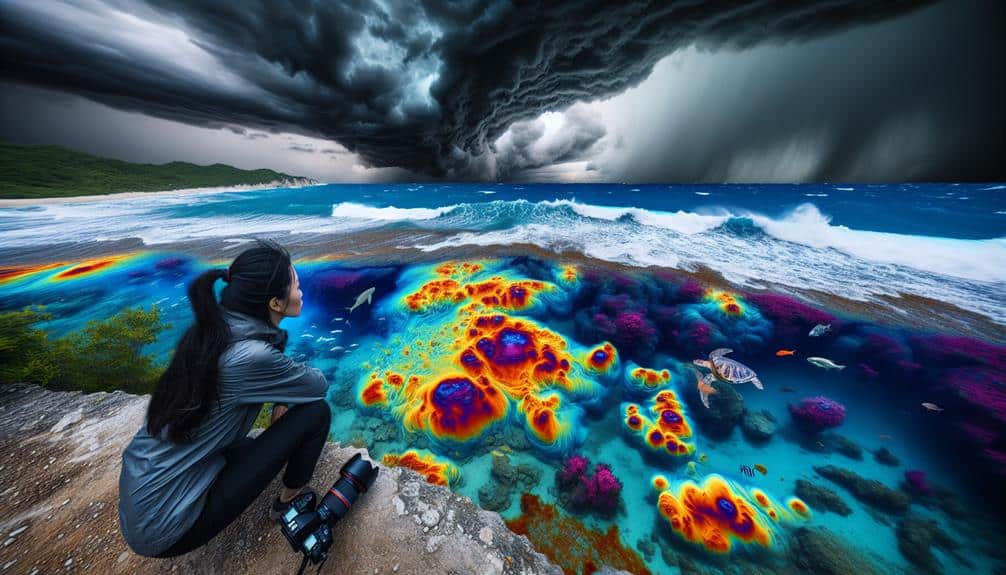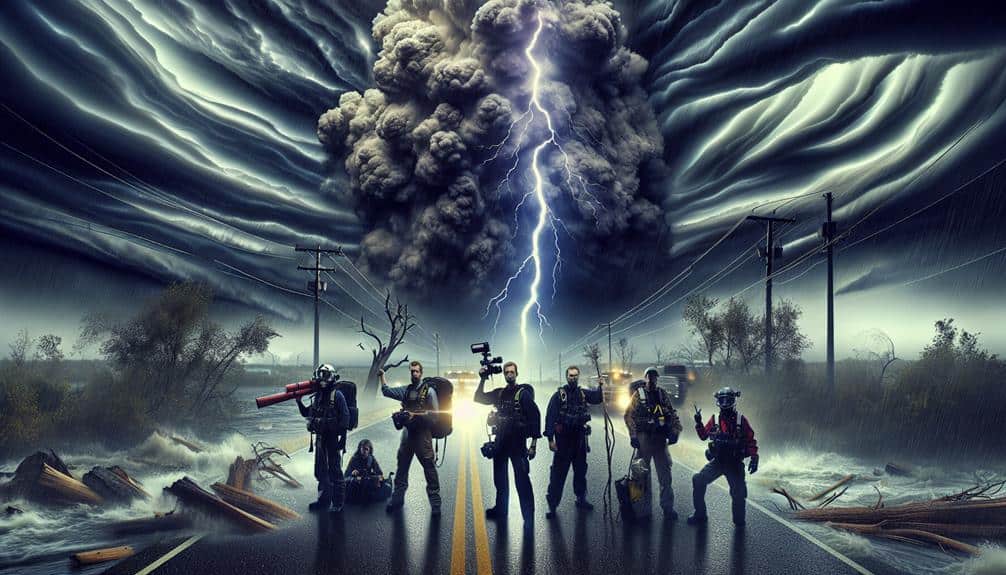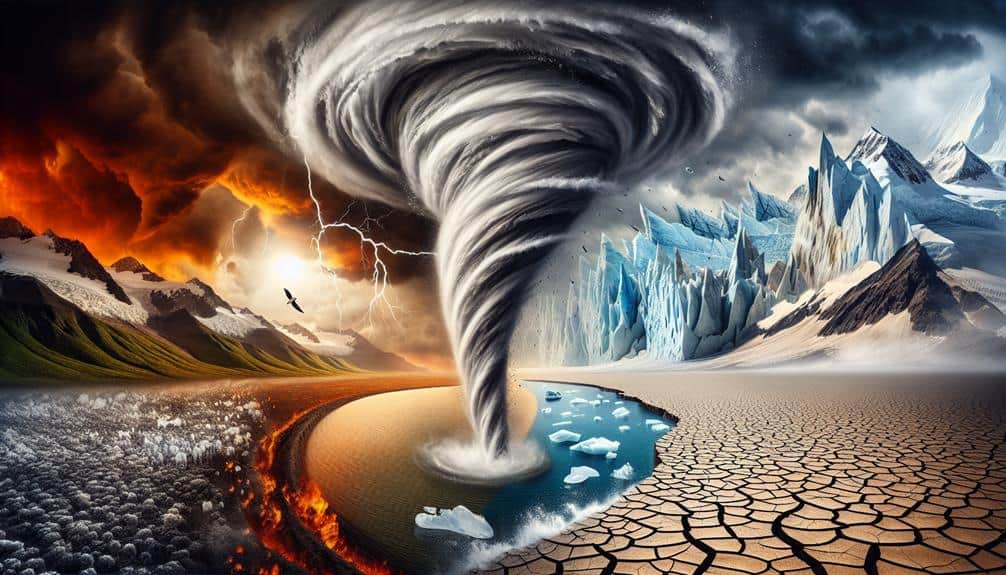We're noticing the impacts of climate change because storm frequency has surged by 20% in the past 30 years, and storm intensity is increasing, linked to higher atmospheric energy levels. Storms are now occurring in new regions and seasons, driven by warmer sea surface temperatures and altered jet streams. Advanced technology like Doppler radar and AI-enhanced predictive models helps us track these shifts in real-time. Rising ocean temperatures are extending storm seasons, leading to stronger storms and more unpredictable weather events. Understanding these patterns and their causes is essential for anticipating future changes.
Key Points
- Significant increase in storm frequency and intensity over the past 30 years, correlating with climate change.
- Shifting geographical storm patterns, driven by warmer ocean temperatures and altered jet streams.
- Extended storm seasons due to rising ocean temperatures and prolonged favorable meteorological conditions.
- Enhanced predictive models using AI and machine learning enable better identification of climate change impacts on storms.
Increased Storm Frequency
Recent data indicates that we've seen a marked increase in storm frequency over the past few decades, correlating strongly with rising global temperatures. From a storm chasers' perspective, this uptick isn't merely academic; it's a tangible shift in our field experiences.
As climate change progresses, the environmental implications become increasingly pronounced. We're not just seeing more storms; we're seeing them in places and times of the year where they were previously rare.
Analyzing storm frequency data, we find a compelling correlation with higher sea surface temperatures and altered atmospheric conditions. These changes foster environments conducive to storm formation more frequently. For example, NOAA reports show a 20% increase in storms over the past 30 years. This aligns with global temperature data showing a steady rise, underscoring the interplay between climate change and storm activity.
Increased storm frequency has significant environmental implications. It accelerates coastal erosion, disrupts ecosystems, and strains our infrastructure. As storm chasers, we're on the front lines, witnessing firsthand how these changes manifest. Our data-driven observations highlight an urgent need for adaptive strategies.
In this era of climate change, understanding and predicting storm frequency is critical for safeguarding our freedoms and mitigating environmental impacts.
Stronger Storm Intensity
We've observed a notable increase in storm intensity, closely linked to the rising energy levels in our atmosphere due to climate change. This uptick in energy leads to more powerful storms, which in turn results in greater destruction. Our data indicates that the average wind speeds and rainfall volumes have surged, elevating the stakes for accurate damage assessment. Higher intensity storms are tearing through communities, causing significant structural damage and increasing the number of emergency response operations.
When we analyze the data, we see that these stronger storms aren't just anomalies but part of a growing trend. The increased energy available in the atmosphere, primarily from higher sea surface temperatures, fuels these storms, making them more destructive. Emergency response teams are now facing unprecedented challenges, requiring faster mobilization and more resources. The cost of damage has skyrocketed, and our assessments show a direct correlation with the storm's increased intensity.
In our commitment to freedom, we must acknowledge that stronger storms bring greater risks. As storm chasers, our role in documenting and understanding these changes is pivotal. By providing accurate data, we can help improve emergency response strategies and mitigate the impacts of these increasingly powerful storms.
Shifting Storm Patterns
As we observe the growing intensity of storms, we also notice a significant shift in their geographical patterns, driven by changing climate dynamics. This shift isn't arbitrary; it's rooted in data and analysis. Warmer ocean temperatures and altered jet streams are redistributing storm activity.
Storms that traditionally hit certain regions are now appearing in areas previously considered low-risk. This redistribution is reshaping our landscapes in profound ways.
For instance, the increased frequency of storms in the Midwest, a region not historically known for such activity, is causing unprecedented environmental effects. We're witnessing more flooding, soil erosion, and altered agricultural patterns. The changing landscapes pose risks to both ecosystems and human settlements.
Coastal regions face heightened storm surges exacerbated by rising sea levels. These patterns aren't just anomalies; they signify a new norm dictated by evolving climate factors.
Extended Storm Seasons
The data indicates that storm seasons are extending beyond their traditional temporal boundaries, driven by prolonged periods of favorable meteorological conditions. We've observed that what used to be confined to a few months now stretches across a larger part of the year. This isn't just an anomaly; it's becoming the new norm, confirmed by multiple datasets and satellite imagery.
Our early warnings systems, designed to predict storms within established seasons, are now being recalibrated. These systems must adapt to this new reality to maintain their efficacy. Predictive models show increased storm activity outside traditional windows, consequently, we've had to extend monitoring periods and update risk assessments continuously.
The environmental impact of these extended seasons is significant. Prolonged storm activity exacerbates soil erosion, disrupts wildlife habitats, and increases the frequency of flooding, affecting both urban and rural areas.
For us storm chasers, this means more frequent deployments and longer durations in the field, pushing our resources and endurance to their limits. The data is clear: extended storm seasons aren't just a future concern; they're a present-day reality requiring immediate adaptation and response.
Rising Ocean Temperatures

Rising ocean temperatures play an essential role in fueling the extended storm seasons we've observed, amplifying both the intensity and frequency of these meteorological events. As ocean temperatures climb, the thermal energy available for storm formation increases, leading to more powerful hurricanes and typhoons. Data shows a clear correlation between warmer ocean surfaces and stronger storm systems.
Additionally, rising temperatures cause significant disruptions in marine ecosystems. Coral bleaching, a direct consequence of elevated sea temperatures, threatens the biodiversity of our oceans. When corals expel the algae living in their tissues due to stress from heat, they lose their vibrant colors and, more importantly, their primary energy source, leading to widespread reef die-offs.
The fishing industry also faces severe repercussions. Ocean acidification, driven by increased absorption of CO2, further compounds the problem. Acidic waters impair the ability of shellfish to form calcium carbonate shells, jeopardizing species that are vital to both ecosystems and economies.
Unpredictable Weather Events
Unpredictable weather events, fueled by climate change, are increasingly disrupting global patterns, challenging our forecasting models and mitigation strategies. As we analyze data, we notice that the frequency and intensity of these events are rising. Extreme storms, unexpected rainfall, and prolonged droughts are becoming common. This unpredictability complicates our ability to forecast accurately, putting our communities and infrastructure at risk.
We've observed that changing landscapes, such as deforestation and urbanization, exacerbate these environmental impacts. For instance, urban areas, with their heat islands, are more likely to experience flash floods due to intense, sudden downpours. Conversely, rural areas suffering from deforestation are more vulnerable to landslides and soil erosion during heavy rains.
In our pursuit of freedom from these volatile conditions, we must adapt our strategies. Traditional models no longer suffice; we need more dynamic, real-time data integration. By leveraging satellite imagery and ground sensors, we can better understand these changing patterns and implement responsive measures.
The environmental impacts are clear: ecosystems are distressed, and human settlements are increasingly at risk. Our challenge now lies in enhancing our predictive capabilities to mitigate these unforeseen weather events effectively.
Storm Chasers' Advanced Technology
We've equipped storm chasers with cutting-edge technology, allowing for real-time data analysis and enhanced predictive models. This data-centric approach lets us understand storm patterns with unprecedented accuracy.
Consequently, we can forecast weather events more reliably, directly impacting public safety and preparedness.
Real-Time Data Analysis
Through the application of advanced technology like Doppler radar and GPS-equipped probes, storm chasers collect and analyze real-time data to understand and predict severe weather patterns. This cutting-edge equipment allows us to engage in sophisticated weather tracking, capturing minute-by-minute changes in storm systems.
By deploying GPS-equipped probes directly into tornadoes and hurricanes, we gather precise measurements of wind speeds, pressure variations, and temperature fluctuations.
Data visualization plays an essential role in our analysis. Advanced software transforms raw data into comprehensible graphs and models, enabling us to identify trends and anomalies swiftly. These visual tools help us decode the complexities of storm behavior and offer immediate insights that are invaluable for making quick decisions in the field.
Our real-time data analysis doesn't just end with collection; it requires rigorous scrutiny. We use high-resolution Doppler radar to detect rotational patterns in storm clouds, which can signal the formation of a tornado. By integrating this real-time data with historical weather patterns, we can pinpoint areas most likely to experience severe weather.
In essence, our reliance on advanced technology and real-time data analysis empowers us to stay ahead of rapidly changing weather conditions, offering a degree of freedom to predict and understand storms more effectively.
Enhanced Predictive Models
Advancements in machine learning and artificial intelligence have greatly enhanced our predictive models, allowing us to forecast storm pathways with unprecedented accuracy. By leveraging vast datasets and complex algorithms, we can now analyze patterns in atmospheric conditions that were previously undetectable. This capability gives us a significant edge in predicting storm behavior, which is essential for more accurate forecasting and effective climate adaptation strategies.
Machine learning algorithms have enabled us to process real-time data from various sources, such as satellite imagery, radar, and weather stations, all while factoring in the nuances of climate change. These advanced technologies can detect even subtle shifts in weather patterns, allowing us to anticipate extreme weather events with a higher degree of certainty. As a result, we can make more informed decisions, enhancing our readiness and response efforts.
Moreover, AI-driven models continuously learn and improve from each storm season, refining their predictive capabilities. This constant evolution guarantees that our forecasting models remain at the cutting edge, offering a reliable tool to mitigate the impacts of climate change. By embracing these technological advancements, we empower ourselves to adapt more effectively to an increasingly volatile climate, safeguarding both lives and property.
Frequently Asked Questions
How Do Storm Chasers Prepare for Extreme Weather Conditions?
We prioritize equipment readiness and establish emergency protocols before heading out. Ensuring forecast accuracy helps us predict extreme weather conditions. This technical preparation maximizes safety and allows us to operate effectively and freely in unpredictable environments.
What Safety Measures Do Storm Chasers Take During a Chase?
We take safety precautions seriously, ensuring our equipment maintenance is up-to-date and our communication protocols are robust. During a chase, we're ready for emergency response, keeping constant contact to manage risks and protect our freedom.
How Do Storm Chasers Contribute to Scientific Research on Climate Change?
We collect research data, collaborate with scientists, employ advanced observation techniques, and utilize cutting-edge technology. Our efforts lead to valuable insights into climate change patterns, enhancing predictive models and contributing greatly to the scientific community's understanding.
What Type of Vehicles Do Storm Chasers Typically Use?
We typically use vehicles with off-road capabilities and advanced technology, such as modified SUVs and trucks. These allow us to navigate rough terrain and gather precise data, ensuring we can operate effectively and safely in extreme weather conditions.
How Do Storm Chasers Communicate and Coordinate During a Chase?
We use various communication methods and coordination strategies, leveraging technology advancements for real-time updates. Mobile apps, satellite data, and radio systems guarantee we're synchronized and adaptable, maximizing our efficiency and safety during intense storm chases.


